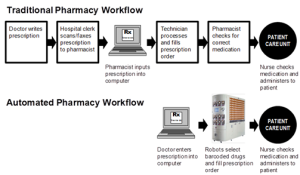Politics
Automation in Pharmacy: A Key to Boost Pharmacy Work at 10X Pace
Published
2 years agoon
By
Drew Simpson
Automation is unclosing the new opportunities for the healthcare sector to thrive without hassle. In addition, it eliminates the extreme workload pressure in the healthcare ecosystem, especially in pharmacy stores.
Automation in pharmacy means peace of mind to patients, staff members, and stakeholders.
The real meaning of automation in pharmacy
People think that automation is all about robots taking charge.
But in reality, it’s more than just a robot.
Automation in pharmacy is an advanced system or software solution that automates repetitive tasks to eliminate manual errors, streamline workflows, speed up the process, ensure operational efficiency, and save time, costs, and resources.
Repetitive tasks include
This means the ultimate goal of the pharmacy automation system is to make life easier for pharmacists using robust tech.
A rise of the new era. The lucrative market is the proof itself.
As per the exclusive report from the Globe News Wire, “The Global Pharmacy Automation Market size is valued at USD 5,083 Million in 2021 and is expected to reach USD 10,402 Million by 2030.”
For pharmacies, improving efficiency and accuracy has always been a significant headache.
When we look at the past, the early forms of the automation system were expensive for pharmacies.
But the current scenario is entirely different. Pharmacies can now quickly implement advanced and robust automation software and machines at an affordable expense.
The adoption of automation is rising at a rapid pace in pharmacies or drug stores.
For instance, automated data-entry and dispensing systems, auto-refill, storage, and retrieval systems are standard automation solutions in pharmacies.
Automation has made a positive impact on the productivity, performance, and efficiency of the pharmacy.
The rising demand for lower medication or human errors will drive the entire pharmacy automation market.
How does automation perform in the pharmacy ecosystem? A technical context
The aim is to automate repetitive tasks. So, let’s explore what cooks behind the doors.
1. Tech scenario
RPA (Robotic Process Automation) drives manual workflows in autopilot mode.
It helps in creating and managing software robots.
Software robots are advanced tech solutions that perform tasks just like humans.
For instance, it understands, manages, and completes the data entry process faster and more efficiently.
2. Now, RPA tools are in action
You can’t build or deploy software robots into the pharmacy system without RPA tools.
UiPath (uipath dotcom) is one of the top RPA platforms to build RPA tech to automate repetitive tasks.
After creating a program, you can download it as a .exe file.
But remember, there are two ways – attended and unattended programs.
Attended means a manual start is needed, while unattended, the program automatically starts as per the scheduled time.
3. Now it’s time to install
Install a .exe file into the computer. Now your computer-based repetitive task is in autopilot mode, just like Tesla.
Pharmacy areas that are experiencing the positive outcomes of the automation
One can automate the following computer-based repetitive tasks in the pharmacy.
- Auto-refill to reduce the hassle of patients’ calls and text messages
- Automated inventory management to avoid the headache of the time-consuming and costly processes
- Automatic billing and invoicing to eliminate tedious procedures and manual errors
- Email and SMS automation to notify the patients about their refills and other things
- Automated pharmacy management to keep everything under the same roof
- Automated patient data tracking system
- Remote dispensing system
Automation brings happiness in the true sense
Automation opens endless possibilities for patients, pharmacy staff, and stakeholders to eliminate their headaches with ease.
- Efficient and streamlined workflows
- It makes the pharmacy ecosystem faster and more flexible
- Allows pharmacists to focus on other key areas
- Humans make mistakes. Automation doesn’t
- It improves the work productivity of the staff.
- Reduces the patient data management hassle
- Helps in avoiding the mess of the inventory management
- Auto-refills prescriptions that save time and resources
- Improves patient care experience and satisfaction
- Eliminates the human errors that enhance the patient safety
- Faster and efficient communication
- Ensures operational efficiency
- Improves the accuracy of the workflows
Technologies in the automation systems
1. RPA (Robotic Process Automation):
We both are familiar with how RPA is becoming a helping hand for the pharmacy. It reduces the work burden of the staff and gives them peace of mind in the true sense.
But there are still limitations of the RPA.
It cannot think for itself and performs the task based on the analysis. This means it performs input for the fixed output.
In addition to this, it also requires well-structured data to perform tasks more efficiently.
2. OCR (Optical Character Recognition):
OCR has emerged as the revolutionary tech solution in almost every sector.
The advanced technology automatically extracts the data from the image, PDF, and written text and converts it into a readable and editable format.
Automating the prescription ordering process is one of the drug store’s most common use cases of OCR.
However, it also needs a well-structured data formation to give an accurate output.
3. Artificial Intelligence:
With zero doubt, AI is now an integral part of the entire healthcare ecosystem.
From improving patient care experience to reducing the burnout of the clinical staff, AI in healthcare has shown positive results in almost every corner.
AI enables the pharmacies to make data-driven decisions and automate manual tasks such as personalized messages to patients etc.
What makes it exceptional from the rest is that AI holds the potential to think for itself for the given task or change in the output.
Lastly, an AI-based OCR system also helps get the ideal outcome even from the unstructured data format.
The future of the pharmacy automation
The pharmacy market is experiencing a growing trend of automation adoption.
RPA, AI, OCR, and ML are creating new opportunities in almost every inch of the pharmacy.
But still, pharmacists are performing double-checking systems on the prescription as automation is still in development.
However, the advancement of these technologies in pharmacy app development and software development has the potential to bring 100% accuracy in the next few years.
More importantly, AI harnesses the true power of big data that allows pharmacists to analyze risk patterns.
Here are some of the future needs for automation in pharmacy.
- Faster and more efficient medication dispensing
- More effective and outcome-driven patient data management
- Better management system for the inventory and resources
- 100% accuracy in the repetitive tasks
To sum it up
Automation is bringing flexibility, scalability, and affordability into the pharmacy sector.
It adds result-driven value to the everyday task of the pharmacy team by allowing them to keep an eye on the other vital aspects of the ecosystem.
As a result, pharmacies can now achieve their business goals without compromising costs, labor, and time.
The aim is to bring magic into the life of the patients, pharmacists, and stakeholders, and automation is doing wonders for the same.
Parth Patel
Parth Patel is a serial entrepreneur and CEO of SyS Creations which is a top healthcare app development . Operating the IT Infrastructure of SMEs and startups keeps him on his toes and his passion for helping others keeps him motivated.
You may like
-


Augmenting the realities of work
-


Ketamine is easier to prescribe than ever, and the FDA is not happy about it
-


Oyster fight: The humble sea creature could hold the key to restoring coastal waters. Developers hate it.
-


Accel leads Lottie’s series A round, elevating the UK’s care services with a £16.35M boost
-


China rolls out plan to boost computing power infrastructure
-


How AI is Changing Data Management: Embracing the AI-Driven Automation Era
Politics
Fintech Kennek raises $12.5M seed round to digitize lending
Published
7 months agoon
10/11/2023By
Drew Simpson
London-based fintech startup Kennek has raised $12.5 million in seed funding to expand its lending operating system.
According to an Oct. 10 tech.eu report, the round was led by HV Capital and included participation from Dutch Founders Fund, AlbionVC, FFVC, Plug & Play Ventures, and Syndicate One. Kennek offers software-as-a-service tools to help non-bank lenders streamline their operations using open banking, open finance, and payments.
The platform aims to automate time-consuming manual tasks and consolidate fragmented data to simplify lending. Xavier De Pauw, founder of Kennek said:
“Until kennek, lenders had to devote countless hours to menial operational tasks and deal with jumbled and hard-coded data – which makes every other part of lending a headache. As former lenders ourselves, we lived and breathed these frustrations, and built kennek to make them a thing of the past.”
The company said the latest funding round was oversubscribed and closed quickly despite the challenging fundraising environment. The new capital will be used to expand Kennek’s engineering team and strengthen its market position in the UK while exploring expansion into other European markets. Barbod Namini, Partner at lead investor HV Capital, commented on the investment:
“Kennek has developed an ambitious and genuinely unique proposition which we think can be the foundation of the entire alternative lending space. […] It is a complicated market and a solution that brings together all information and stakeholders onto a single platform is highly compelling for both lenders & the ecosystem as a whole.”
The fintech lending space has grown rapidly in recent years, but many lenders still rely on legacy systems and manual processes that limit efficiency and scalability. Kennek aims to leverage open banking and data integration to provide lenders with a more streamlined, automated lending experience.
The seed funding will allow the London-based startup to continue developing its platform and expanding its team to meet demand from non-bank lenders looking to digitize operations. Kennek’s focus on the UK and Europe also comes amid rising adoption of open banking and open finance in the regions.
Featured Image Credit: Photo from Kennek.io; Thank you!
Radek Zielinski
Radek Zielinski is an experienced technology and financial journalist with a passion for cybersecurity and futurology.
Politics
Fortune 500’s race for generative AI breakthroughs
Published
7 months agoon
10/11/2023By
Drew Simpson
As excitement around generative AI grows, Fortune 500 companies, including Goldman Sachs, are carefully examining the possible applications of this technology. A recent survey of U.S. executives indicated that 60% believe generative AI will substantially impact their businesses in the long term. However, they anticipate a one to two-year timeframe before implementing their initial solutions. This optimism stems from the potential of generative AI to revolutionize various aspects of businesses, from enhancing customer experiences to optimizing internal processes. In the short term, companies will likely focus on pilot projects and experimentation, gradually integrating generative AI into their operations as they witness its positive influence on efficiency and profitability.
Goldman Sachs’ Cautious Approach to Implementing Generative AI
In a recent interview, Goldman Sachs CIO Marco Argenti revealed that the firm has not yet implemented any generative AI use cases. Instead, the company focuses on experimentation and setting high standards before adopting the technology. Argenti recognized the desire for outcomes in areas like developer and operational efficiency but emphasized ensuring precision before putting experimental AI use cases into production.
According to Argenti, striking the right balance between driving innovation and maintaining accuracy is crucial for successfully integrating generative AI within the firm. Goldman Sachs intends to continue exploring this emerging technology’s potential benefits and applications while diligently assessing risks to ensure it meets the company’s stringent quality standards.
One possible application for Goldman Sachs is in software development, where the company has observed a 20-40% productivity increase during its trials. The goal is for 1,000 developers to utilize generative AI tools by year’s end. However, Argenti emphasized that a well-defined expectation of return on investment is necessary before fully integrating generative AI into production.
To achieve this, the company plans to implement a systematic and strategic approach to adopting generative AI, ensuring that it complements and enhances the skills of its developers. Additionally, Goldman Sachs intends to evaluate the long-term impact of generative AI on their software development processes and the overall quality of the applications being developed.
Goldman Sachs’ approach to AI implementation goes beyond merely executing models. The firm has created a platform encompassing technical, legal, and compliance assessments to filter out improper content and keep track of all interactions. This comprehensive system ensures seamless integration of artificial intelligence in operations while adhering to regulatory standards and maintaining client confidentiality. Moreover, the platform continuously improves and adapts its algorithms, allowing Goldman Sachs to stay at the forefront of technology and offer its clients the most efficient and secure services.
Featured Image Credit: Photo by Google DeepMind; Pexels; Thank you!
Deanna Ritchie
Managing Editor at ReadWrite
Deanna is the Managing Editor at ReadWrite. Previously she worked as the Editor in Chief for Startup Grind and has over 20+ years of experience in content management and content development.
Politics
UK seizes web3 opportunity simplifying crypto regulations
Published
7 months agoon
10/10/2023By
Drew Simpson
As Web3 companies increasingly consider leaving the United States due to regulatory ambiguity, the United Kingdom must simplify its cryptocurrency regulations to attract these businesses. The conservative think tank Policy Exchange recently released a report detailing ten suggestions for improving Web3 regulation in the country. Among the recommendations are reducing liability for token holders in decentralized autonomous organizations (DAOs) and encouraging the Financial Conduct Authority (FCA) to adopt alternative Know Your Customer (KYC) methodologies, such as digital identities and blockchain analytics tools. These suggestions aim to position the UK as a hub for Web3 innovation and attract blockchain-based businesses looking for a more conducive regulatory environment.
Streamlining Cryptocurrency Regulations for Innovation
To make it easier for emerging Web3 companies to navigate existing legal frameworks and contribute to the UK’s digital economy growth, the government must streamline cryptocurrency regulations and adopt forward-looking approaches. By making the regulatory landscape clear and straightforward, the UK can create an environment that fosters innovation, growth, and competitiveness in the global fintech industry.
The Policy Exchange report also recommends not weakening self-hosted wallets or treating proof-of-stake (PoS) services as financial services. This approach aims to protect the fundamental principles of decentralization and user autonomy while strongly emphasizing security and regulatory compliance. By doing so, the UK can nurture an environment that encourages innovation and the continued growth of blockchain technology.
Despite recent strict measures by UK authorities, such as His Majesty’s Treasury and the FCA, toward the digital assets sector, the proposed changes in the Policy Exchange report strive to make the UK a more attractive location for Web3 enterprises. By adopting these suggestions, the UK can demonstrate its commitment to fostering innovation in the rapidly evolving blockchain and cryptocurrency industries while ensuring a robust and transparent regulatory environment.
The ongoing uncertainty surrounding cryptocurrency regulations in various countries has prompted Web3 companies to explore alternative jurisdictions with more precise legal frameworks. As the United States grapples with regulatory ambiguity, the United Kingdom can position itself as a hub for Web3 innovation by simplifying and streamlining its cryptocurrency regulations.
Featured Image Credit: Photo by Jonathan Borba; Pexels; Thank you!
Deanna Ritchie
Managing Editor at ReadWrite
Deanna is the Managing Editor at ReadWrite. Previously she worked as the Editor in Chief for Startup Grind and has over 20+ years of experience in content management and content development.
